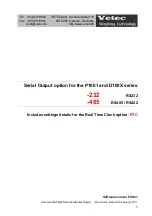
31
<CD>
Cyclic Data
Mapped Variables
Description
Update all eight input variables using floating point numbers
Parameters
None
Modes
All Modes
Notes
The concepts and usage of Standard Screens, Cyclic Data and Mapped Variables are discussed in
their own section starting on Page 15.
The <CD> Cyclic Data command is used to update all eight input variables at the same time. Instead
of an ASCII string, the values are sent as IEEE floating point numbers. In addition, the status of each
value can be set
GOOD
or
BAD
. The data format is a single status byte followed by 4-byte float for
each variable. The status byte for each value should be set to zero to mark that value as
BAD
, or any
value between 1 and 255 to mark it as
GOOD
.
The command <CD> is issued with any additional bytes (checksum, CRC etc) as required by the
current operational mode. The command is acknowledged if correctly received.
A binary download (from the host to the display) of the input values is then expected. The length
must be (1+4)x8 = 40 bytes and if not an error response is returned.
After the data has been downloaded the <CI>, <CCn>, or <CRnn> command must be sent as per the
current operational mode, the check byte(s) being calculated from all 40 bytes of the input data.
The download is acknowledged if it was correctly received (including checksum or CRC checks) and
the values are displayed.
There is a 2 second timeout for the download operation, during which time if no bytes are received
the download is aborted and an error response is returned. Of course, the actual total download time
depends on the speed of the serial link.
Uses
The <CD> command allows:
•
Displayed variables may be updated and the screen redrawn with minimal host overhead
•
Standard screens to be used for the convenient display of up to eight process variables with
little application programming
•
More complex screens can be built up using other “Mapped Variable commands”
Example
See the Standard Screens section (Page 15)
See Also
CT
Cyclic-data Timeout
CV
Cyclic Variable
















































